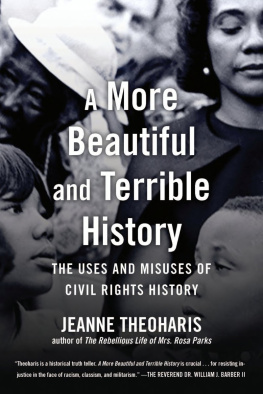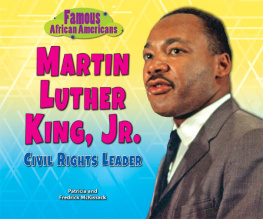
To Julian Bond, who taught me how to tell this story and carry this history forward
And to my parents, Nancy and Athan Theoharis, for their commitment to and insistence on justice, truth-telling, and perseverance
PREFACE
A Dream Diluted and Distorted
Its a system of power that is always deciding in the name of humanity who deserves to be remembered and who deserves to be forgotten.... We are much more than we are told. We are much more beautiful.
Eduardo Galeano
American history is longer, larger, more various, more beautiful, and more terrible than anything anyone has ever said about it.
James Baldwin, A Talk to Teachers
BY THE TURN OF THE MILLENNIUM , the history of the civil rights movement had become a national story. When asked to name a most famous American other than a president from Columbus to today, high school students most often chose Martin Luther King Jr. and Rosa Parks. Students chose two freedom fighters who in life had challenged the racial injustice at the heart of American society and who had often been treated as un-American for doing so. Now the civil rights movement had come to embody American grit, courage, and resolve, and these two activists could be invoked as the countrys most famous emblems.
Arguably beginning when President Ronald Reagan signed the bill in 1983 to make the third Monday of January a federal holiday for Martin Luther King Jr., the political uses of memorializing the movement took on heightened possibility as a national narrative. Fifteen years of opposition to the holiday gave way to recognizing its political utility. The civil rights movement became a way for the nation to feel good about its progressand Kings legacy became enshrined in his dream speech. His popularity expanded. By 1987, 76 percent of Americans held a favorable opinion of the civil rights leader, almost the reverse of his popularity at the end of his life (only 28 percent of Americans had a favorable opinion of him in 1966).
At the same time, memorials to the civil rights movement became national eventsfrom President Bill Clintons trip to Little Rock for the fortieth anniversary of the Little Rock Nines desegregation of Central High School, to Congresss decision to have Rosa Parkss coffin lie in honor in the Capitol, to the First Familys trip to Selma, Alabama, on the fiftieth anniversary of the Selma-to-Montgomery march. These national events honored not just the work of the civil rights activists but the advancement of the nation itself. They marked the Americanness of the civil rights struggle, and held up the power of US democracy and progress to the world.
Political leaders, pundits, and citizens came to see and tell the story of the modern civil rights movement as one of progress and national redemption. Jim Crow was framed as a horrible Southern relic, and the movement to unseat it became a powerful tale of courageous Americans defeating a long-ago evil. Activists from Paul Robeson to Malcolm Xwho had once been deemed national security threatsshowed up on postage stamps. A movement that had challenged the very fabric of US politics and society was turned into one that demonstrated how great and expansive the country wasa story of individual bravery, natural evolution, and the long march to a more perfect union.
A story that should have reflected the immense injustices at the nations core and the enormous lengths people had gone to attack them had become a flattering mirror. The popular history of the civil rights movement now served as testament to the power of American democracy. This framing was appealingsimultaneously sober about the history of racism, lionizing of Black courage, celebratory of American progress, and strategic in masking (and at times justifying) current inequities. This history as national progress naturalized the civil rights movement as an almost inevitable aspect of American democracy rather than as the outcome of Black organization and intrepid witness. It suggested racism derived from individual sin rather than from national structureand that the strength of American values, rather than the staggering challenge of a portion of its citizens, led to its change. The movement had largely washed away the sins of the nation, and Americas race problem could be laid to rest with a statue in the Capitol.
In the process, politicians and others shrank the progressive, expansive, challenging vision of the modern Black freedom struggle into something more passive, individualistic, and privatizeda dream diluted and distorted. The celebration of the movement became a way to avoid acknowledging the enormous gap between [Americas] practices and its professions, as historian John Hope Franklin had explained. And it became a way to take the beauty and power away from one of the most successful social movements of the twentieth century and the vision it offers us for today.
The recounting of national histories is never separate from present-day politics. What of the past is remembered, celebrated, and mourned is at the core of national identityand the process of what is told and not told is often a function of power. The act of making an historical tribute necessarily resolves it and fixes it in time and place. As anthropologist Michel-Rolph Trouillot observes, the task of commemoration help[s] to create, modify or sanction the public meanings attached to historical events deemed worthy of mass celebration... to create a past that seems both more real and more elementary.
Racial injustice is Americas original sin and deepest silence. So, paradoxically, the ways the nation has memorialized the civil rights movement has become a way to maintain such silences. The history of American racism had become just that... history. While these tributes honored the movement, they simultaneously depoliticized the scope of the struggle, distorted the work of the activists honored, demonized Black anger, and obscured ongoing calls for racial justice through a celebration of a nearly postracial, self-correcting America.
No better proof of the countrys progress was the election and presidency of Barack Obama. Movement symbolism was highlighted throughout the 2008 election, both by the Obama campaign itself and by others. Candidate Obama accepted the Democratic nomination for president on August 28, 2008the forty-fourth anniversary of the March on Washington. Posters decorated churches and community centers, telephone poles and schools, delineating this historical progression: Rosa sat so Martin could walk. Martin walked so Obama could run. Obama ran so our children could fly. By voting for him, individuals could help realize the dream. Many trumpeted Obamas victory as the culmination of the civil rights movement and a testament to a postracial Americaan America that had largely moved past its history of racism. Even those who did not share such a rosy view of American progress were awed by the immensity of seeing the election of a Black man to the presidency of the United States. Given the momentous nature of his victory, referencing the history of the movement became more central to the presidency of Barack Obama than that of any of his predecessorsand the president himself, his supporters, and many commentators regularly appealed to its legacy.
And the public who elected him rejoiced in it. Used as a way to bask in our own association with this grand historical line, the civil rights movement had become our national redemption song. The election of President Obama made many of his supporters feel like we had overcome. It had delivered us. And therein lay the dangerrather than a rung on a steep ladder, the election became the zenith, the top of that climb, where all who wished could take credit for the triumph.
Next page










